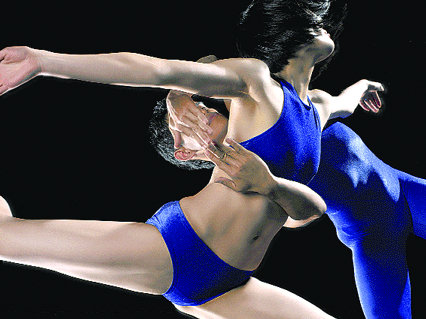Armitage’s movement charged with anima, meaning
My guest and I nearly floated out of the Duke on New 42nd Street after seeing Armitage Gone! Dance opening night. Was it Megumi Eda’s featherweight solos? Was it the elusive connections between the dancers? One light tap or kick and they split, but not for long. Was it the playful banter in the second movement? In this entrancing dance, movement is charged with anima, muscles make meaning.
The five company dancers are highly trained in ballet and other forms, but in Karole Armitage’s new “in this dream that dogs me,” ballet’s verticality has no place. Three face upstage with their arms reaching to connect, and torsos bent forward at the waist, activating the 360-degree area around them with a broader geometry.
Armitage danced Balanchine repertoire in Geneva, and was a member of Cunningham’s company; on that lineage she layers contemporary folk form. Instead of pointe shoes, her dancers wear noiseless peds, carefully matched to their skin-tones of every shade; they hail from Asia, Philadelphia, and the Islands.
Was not movement an earliest form of expression? Krumping has that archaic elemental quality, and so does “…this dream…” She takes her inspiration in part from the new hip-hop style borne in L.A., her dancers gather once in krumping solos, performing for their small group as much as for us. But the cool ferocity in the rippling muscles of krumpers is what Armitage appropriates.
Armitage found the flow and movement of calligraphy an inspiration and modeled the structure of the dance on this ancient written narrative. Though it has a dream-like logic, it feels much like the natural flow of events in time, as if we are in the dream. Battle, friendship, and love are episodes in “…this dream…”
The music is electronically altered traditional instruments composed by Annie Gosfield and played live in the balcony. Its structure is also based on calligraphy and the first movement is danced to tangy, tinny tones.
The dancers are angular or sinuous in blue Lycra unitards designed by Peter Speliopoulos, open at the back; the pattern of skin and blue is electric, accentuating the figures. Guests in red enter in the last movement and there’s a final ethereal duet in white leotards for Eda and Theresa Ruth Howard. Is there a worldview in the emblematic color scheme?
The walls are painted red and a floor to ceiling curtain creates a saffron yellow stripe on one side in David Salle’s set design. A giant flexible duct is hung across the back wall, sharply reflecting and deflecting the light like a segmented mechanical worm. It serves as a foil for the dancers’ grace. The tube, a conduit for air, is the conceptual version of Salle’s new tornado paintings. The set piece is integrated on the stage of moving dancers visually by its enormity and oddity.
In a lyric second movement Felix, Fan plays cello on stage, he is an objet désiré and curiosity for Eda. He is unfazed when she takes up his bow, but when William Isaac swipes his music book the lights go dim and they transition to the final third of the dance.
Shen-Wei in his “Connect-Transfer” also sought to bring plastic calligraphic shapes to life. Armitage achieves that aided by the intimate view the Duke theater space affords. Her movement is also colored by the individual attributes of her company dancers. Eda’s lightness is complemented by Isaac’s solidity, as he stands wall-like behind her, his presence is grand in the third movement. The singular Howard’s musculature ripples to the bursting point; her and Isaac’s extensions are pointed like sublimated weaponry. The virtuosity of Leonides D. Arpon delights whenever he is on stage, while Brian Carey Chung glistens near the end. The group of red-clad guests touch them lightly, shadowing them. A whole new element, they don’t so much break the spell as add spice and complexity.
gaycitynews.com



































